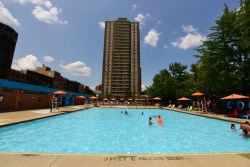Dry Dock Playground
Dry Dock Playground
The lower Manhattan neighborhood surrounding this playground was once known as the Dry Dock District. The area received its nickname in the mid-19th century from the iron works and ship fitters that bustled with the activity of more than 2,000 local workers. Dock workers, mechanics and shipbuilders worked at companies such as Novelty Iron Works, the Sector Iron Works, Young and Cutter, and Cornelius H. Delameter.
The City of New York was assigned this property as a part of the Tompkins Square Urban Renewal Area project in 1964, and Dry Dock Playground opened in June 1975. The renewal project began in 1961 and sought to improve the neighborhood by replacing tenement housing, warehouses, and abandoned factories with shops, artist studios, and 900 units of middle-income housing. The City added parks and off-street parking, and widened streets to entice new residents. Only St. Emeric's Church on East 13th Street and P.S. 34 were left untouched during the renovation. To this day the playground is jointly operated by Parks and P.S. 34.
This parkland has also been known as the Szold Playground. Like Szold Place, which forms the park's border with Avenue D and East 10th Street, Szold Playground was named for Henrietta Szold (1860-1945), a founder of Hadassah, a women's Zionist organization. In 1988, the park was renamed Dry Dock Playground. The park's swimming area, which retains the name Szold Pool, includes both a three-and-a-half foot deep outdoor pool measuring 60 feet wide by 75 feet long and a one and a half foot deep wading pool measuring 15 feet wide by 30 feet long. The pools are open from July 1 to Labor Day.
Across from the park on Avenue D stand the Jacob Riis Houses, a housing project built in the 1949, named in honor of Riis, a crusading journalist, author, and photographer. Born in Denmark, Jacob August Riis (1849-1914) immigrated to New York in 1870 and worked odd jobs, sometimes sleeping in doorways when money was scarce. In 1877, the New York Tribune hired Riis as a police reporter, and he soon began documenting poverty even more dire than he had experienced, particularly in Manhattan's Lower East Side and Five Points. Around 1887, Riis developed an interest in photography and took his camera on trips inside overcrowded tenements and seedy drinking holes. "How the Other Half Lives," Riis' book of essays and photographs detailing the lives of various immigrant groups in the Lower East Side, was released in 1890 and became a national sensation. Reformers, most notably then City Police Commissioner and soon to be the 26th President of the United States Theodore Roosevelt (1858-1919), hailed Riis as a hero, and pushed for legislation aimed at improving living conditions in the slums.
In 1991, the park underwent a $500,000 renovation. Pathways were repaved, curbs were built, and an old public restroom was removed. New basketball backboards, chain link fences, benches, game tables, and play equipment with safety surfacing were added. A new lighting system was installed, and young trees, including many maples, were planted. In 1999, new fencing and interior lights were installed at the pool.
Check out your park's Vital Signs
Clean & Safe
Green & Resilient
Empowered & Engaged Users
Share your feedback or learn more about how this park is part of a
Vital Park System










